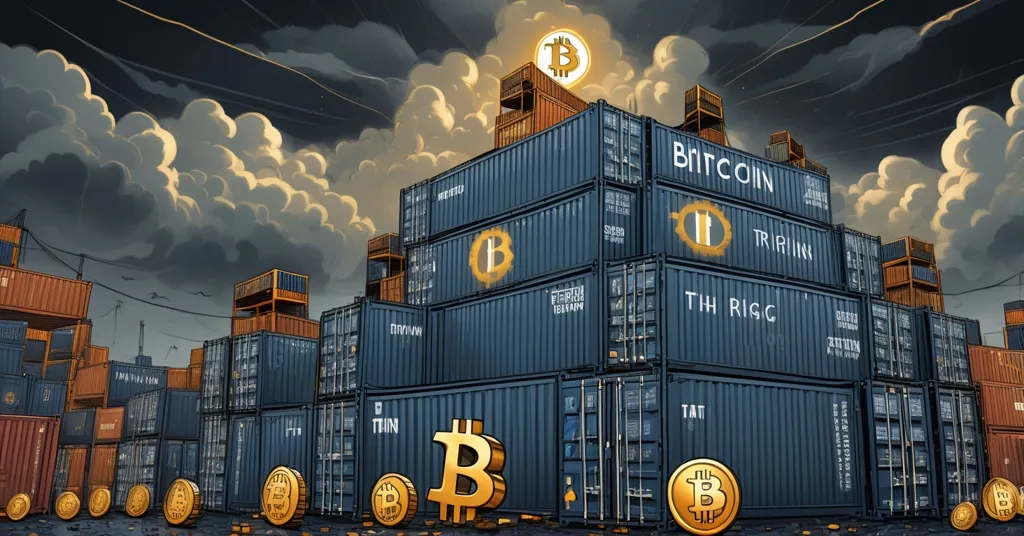Trump’s Tariffs Threaten Bitcoin Mining and Blockchain Innovation with Cost Surges

Trump’s Tariffs: A Stealth Attack on Bitcoin Mining and Blockchain Freedom?
Trump’s tariff blitz is slamming American consumers with higher prices on everything from toothpaste to TVs, but the shockwaves don’t stop at your shopping cart. These import duties, billed as a shield for domestic industry, are poised to rattle the cryptocurrency and blockchain worlds, hiking costs for Bitcoin miners and potentially choking decentralized innovation at a critical juncture.
- Consumer Crunch: Tariffs have driven a 1.8% rise in prices, slashing household income by roughly $2,400 annually.
- Crypto Hardware Hit: Bitcoin mining gear costs could spike by 10-20% due to import duties, threatening U.S. miners’ competitiveness.
- Innovation at Risk: Blockchain startups face pricier tech, slowing the disruptive push we champion.
- Silver Lining? Economic pain might fuel Bitcoin adoption as a hedge against inflation and overreach.
The Economic Gut Punch of Tariffs
Let’s lay out the battlefield. On April 2, dubbed “Liberation Day” by the administration, Trump rolled out a sweeping tariff regime that’s pushed the U.S. average import duty to a staggering 18.2%—a century-high, according to Yale’s Budget Lab data (though some data pegs it closer to 20.2% before consumers switch to cheaper alternatives). The goal? Protect American jobs and flood federal coffers with revenue, with officials touting receipts already outpacing 2024 by tens of billions and projecting “trillions” over the decade. Sounds great on a campaign poster, but the reality is a mess. Reuters estimates companies are staring down an extra $7.1 to $8.3 billion in costs this year alone, and they’re not eating that bill. Procter & Gamble is hiking prices by 5% on a quarter of its U.S. products starting soon after their announcement. Luxury brands like EssilorLuxottica (makers of Ray-Ban) and Swatch are slapping on similar increases, while automakers like General Motors and Ford are swallowing billions in losses. Retail giants—think Walmart, Amazon, Best Buy—are next in line to pass the pain to you.
For the average American, this isn’t just a nuisance; it’s a wallet wallop. Yale researchers calculate that consumer prices have jumped 1.8% across the board, equating to an effective income loss of about $2,400 per household. That’s not a rounding error—it’s the price of a decent laptop or a couple months’ rent for many. Budget-conscious shoppers are already abandoning pricier brands, with Nestlé and PepsiCo reporting sluggish sales. Stock markets flinched hard after the announcement, with P&G’s shares cratering 19%, Nestlé down 20%, Kimberly-Clark off 11%, and PepsiCo sliding nearly 7%, even as the broader S&P 500 gained 13%. Worse, economists warn the real sting is coming. As pre-tariff stockpiles dry up by late 2025 or early 2026, inflation could spike further, weaving these higher costs into the fabric of the economy for years, as discussed in expert forecasts on economic impacts.
“You’re going to see companies like Walmart, Amazon, and Best Buy forced to pass price increases to consumers… Main Street has yet to see the fallout from increased tariffs, and they’re going to go higher,” warns Bill George, former Medtronic CEO and Harvard Business School fellow.
But let’s zoom in on our turf: Bitcoin, blockchain, and the decentralized revolution. This trade war isn’t just inflating your grocery bill—it’s a direct assault on the supply chains and ecosystems that power financial freedom. And if you think crypto is some untouchable digital fortress, buckle up, because the fallout is already creeping in, as explored in broader discussions on how Americans are bearing the cost of these policies.
Bitcoin Miners Caught in the Crossfire
Bitcoin mining, the heartbeat of the network, relies heavily on specialized hardware known as ASICs (Application-Specific Integrated Circuits—basically, computers built solely to crunch Bitcoin’s math puzzles). A massive chunk of these rigs comes from China, with manufacturers like Bitmain historically controlling 70-80% of the market. With tariffs hitting imports at a baseline 10%—and up to 15% or more for regions like the EU and Japan, with steeper threats looming for others—U.S.-based miners could see hardware costs surge by 10-20%. Let’s break that down: a typical high-end ASIC rig runs $2,000 to $5,000. Slap on a 15% duty, and you’re tacking on $300 to $750 per unit. For a small operation buying a dozen rigs, that’s an extra $3,600 to $9,000—enough to wipe out months of profit in an industry where margins are already squeezed by halving events (Bitcoin’s programmed reward cuts every four years) and skyrocketing energy bills, a concern highlighted in community discussions on mining hardware costs.
This isn’t just a personal hit; it’s a systemic risk. Higher costs could slow the growth of Bitcoin’s hash rate (the total computing power securing the network) in the U.S., potentially centralizing mining power in countries like Kazakhstan or Canada with cheaper access to gear or fewer trade barriers. For Bitcoin maximalists like myself, who see BTC as the ultimate bastion of decentralization, this is a bitter pill. A policy pitched as “America First” might ironically undermine the very distributed nature that makes Bitcoin a middle finger to centralized control. And for newcomers wondering why this matters—mining isn’t just nerd stuff; it’s what keeps Bitcoin transactions secure and unforgeable. If U.S. miners drop off, the network’s resilience could take a hit, as detailed in analyses of challenges facing the Bitcoin mining industry.
Blockchain Innovation Under Siege
Bitcoin isn’t the only casualty. Blockchain startups and smaller players across the crypto spectrum are getting squeezed too. Many rely on imported electronics for servers, IoT devices, or other gear critical to running nodes for Ethereum, powering DeFi (Decentralized Finance—think lending or trading without banks), or building Web3 solutions (the next-gen internet where users own their data). With retailers set to pass on tariff-driven price hikes, the trickle-down effect could inflate costs for these innovators overnight. Picture a small Ethereum-based lending protocol planning to scale with 50 new servers. A 15% price bump on hardware could mean an extra $7,500 to $15,000 in costs, delaying their launch by months or killing momentum entirely. That’s not a speed bump; it’s a brick wall for the effective accelerationism (e/acc) we cheer—the rapid, disruptive drive toward decentralized systems that upend the status quo, a topic explored in economic impacts on crypto hardware supply chains.
Let’s be real: while I lean Bitcoin maximalist and believe BTC is the purest store of value, altcoins and other blockchains like Ethereum play vital roles. Smart contracts on Ethereum enable innovations Bitcoin, by design, doesn’t tackle. If tariffs choke these ecosystems with higher operational costs, the broader mission of financial revolution suffers. And don’t forget the regressive sting of these policies. Yale data shows tariffs hit lower-income households hardest, with a 3.8% income loss versus 1.1% for the wealthiest. That mirrors crypto’s own accessibility fight—adoption shouldn’t be a rich man’s game, but pricier tech risks making it one, a concern raised in forums questioning how tariffs might affect blockchain innovation.
A Silver Lining for Bitcoin Adoption?
Now, let’s flip the script and hunt for some upside amid the wreckage. With household incomes gutted by thousands and inflation creeping up (Yale projects a short-run 2.0% price bump), more Americans might eye Bitcoin as a refuge from currency devaluation and government meddling. If your dollar buys less at Walmart because of an 18.2% import duty, why not park some wealth in “digital gold” that no tariff can touch? This taps directly into Bitcoin’s core promise of financial freedom and privacy. Historical trends back this up—during the 2021-22 inflation surge, BTC saw price spikes as investors sought hedges, even amidst volatility. Statista’s 2023 surveys also show growing retail interest in crypto ownership, with 16% of Americans holding some form of digital asset. Economic strain could turbocharge that shift, a trend contextualized by policy impacts on cryptocurrency.
That said, don’t pop the champagne yet. While Bitcoin might stand tall as a safe haven, altcoins—often more speculative—could get pummeled in a risk-off market. Yale’s forecast of a 0.8% GDP growth drop and 0.4% unemployment rise in 2025 paints a grim picture for anything perceived as “high risk.” Plus, if the administration’s rumored “rebate” checks for the midterm election cycle flop or fail to offset the pain, public trust in traditional fixes could erode further. Some might funnel that cash into BTC wallets, sure, but others might just tighten their belts across the board.
Decentralized Defiance or Regulatory Trap?
Here’s a wild card worth watching: blockchain itself could strike back against tariff burdens. Decentralized trade finance platforms, using tokenized assets (digital representations of real-world goods) and smart contracts on networks like Ethereum, might let companies sidestep traditional import costs via peer-to-peer deals. Imagine a manufacturer tokenizing inventory on-chain, cutting a direct deal with a buyer, and bypassing bloated customs fees. That’s the kind of disruption I live for—a raw, unfiltered jab at the system. But let’s not get too starry-eyed. Governments aren’t dumb; they’ll sniff this out. Expect regulatory clampdowns under the guise of enforcing tariffs or “protecting revenue.” Look at past U.S. actions—think the SEC’s war on Ripple over XRP classification—as a preview of how trade policies could morph into excuses for tighter crypto controls. KYC (Know Your Customer) mandates on tokenized trade could kill the anonymity and freedom we fight for before these solutions even scale.
Yale’s long-term outlook doesn’t help the optimism either. They project tariffs could shrink GDP by 0.44% annually ($135 billion in 2024 dollars), even after revenue gains. A smaller economic pie means less room for risky bets on innovation, crypto included. Sure, the administration’s dynamic revenue estimate of $2.5 trillion over a decade sounds flashy, but inefficiencies are dragging everyone down. For our community, from OGs to fresh-faced HODLers, this is a stark reminder: global trade wars aren’t just about steel or shampoo—they’re gunning for our miners, our nodes, and our shot at rewriting the financial rulebook.
Key Takeaways and Burning Questions
- How Are Trump’s Tariffs Hurting American Consumers?
They’ve triggered a 1.8% rise in consumer prices, effectively cutting household income by around $2,400, with broader economic drag projected to reduce GDP growth by 0.8% in 2025. - What’s the Impact on Bitcoin Mining Costs?
Tariffs on imported hardware, especially from China, could raise costs by 10-20%, adding hundreds to thousands of dollars per rig and risking U.S. miners’ edge in Bitcoin’s global hash rate. - Are Blockchain Startups and Innovation at Risk?
Absolutely—higher costs for imported tech like servers could delay or derail DeFi and Web3 projects, clashing with the rapid, disruptive growth we root for in decentralized systems. - Could Tariffs Boost Bitcoin Adoption?
Potentially, as economic pain and inflation push Americans toward Bitcoin as a hedge against shrinking purchasing power and government overreach, mirroring past trends during high-inflation periods. - Can Decentralized Tech Dodge Tariff Costs?
Blockchain-based trade via tokenized assets and smart contracts offers a workaround to bypass traditional fees, but regulatory pushback could stifle these solutions with red tape or crackdowns.
Let’s strip away the fluff: Trump’s tariffs are a poisoned chalice. They’re sold as a win for American grit, but they’re hammering consumers and sneaking into the crypto space with a vengeance. As a near-Bitcoin maximalist, I’ll root for BTC to rise as a safe haven amid this economic mess any day. But if the price is strangling miners with insane hardware costs or pricing out blockchain innovators, we’ve got a fight on our hands. This isn’t just policy noise—it’s a direct challenge to the decentralization, freedom, and disruption we stand for. As tariffs reshape economies, will Bitcoin emerge as a defiant refuge, or will supply chain strain clip our wings? That’s the question we’re all wrestling with, and the stakes couldn’t be higher.



